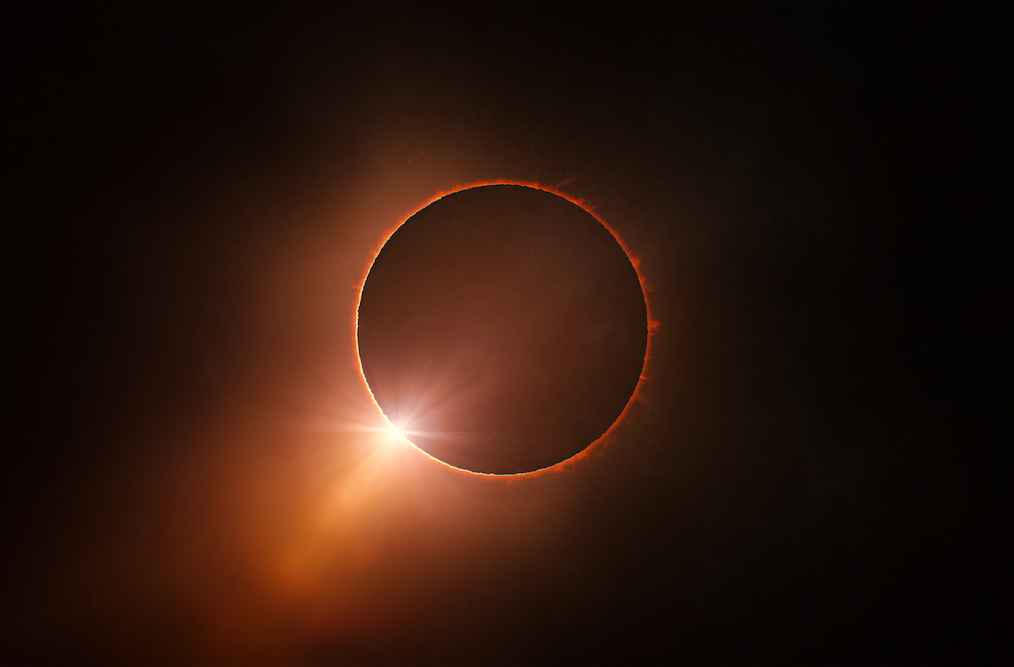I’m sure we’ve all seen our share of videos on social media telling us to run outside and stare at the night sky for a “can’t miss” celestial phenomenon at least once or twice. Usually, it’s a meteor shower or a planet that will be closer to us than ever before; sometimes, it’s even a comet! And while these are certainly sights to see, they typically come with viewing times of 2 in the morning on a weeknight, meaning we probably miss a lot of them. On April 8, 2024, however, there really will be a must-see solar event, and you can take full advantage when you visit Vermont.
A total solar eclipse is set to travel over the northern half of the state, plummeting towns like Killington into dusk in the middle of the day. More than just a moment of shade, a total solar eclipse is other-worldly. Birds go quiet, thinking it’s nighttime. Town streetlights come on, and snake-like shadows crawl on the sidewalks and up buildings, as the sun slips away. If you’ve never seen this wonder in person, or if you’re planning on traveling next year for the event, we’ve compiled some must-know information so you can make the most of the 2024 total solar eclipse in Killington, Vermont.
Understanding the 2024 Total Solar Eclipse

A total solar eclipse is an event where the Moon passes between the Earth and the Sun, completely blocking out the Sun’s light and casting a shadow over certain parts of the Earth. Last seen in North America in August of 2017, the upcoming 2024 total solar eclipse will travel across the continent, starting on the coast of Mexico and tracing a line up through the eastern half of the US and into parts of Canada before ending in the Atlantic Ocean. As you prepare for the event, it’s important to understand the stages of a total solar eclipse so you can make the most of your viewing experience.
1) First Contact: As the Moon begins to cover the Sun’s disk, a small crescent of darkness will appear on the edge of the Sun. This is when viewers enter the penumbra, meaning they’re officially seeing a partial solar eclipse. Those not in the path of totality will remain in varying degrees of the penumbra for the duration of the eclipse.
2) Second Contact: Darkness will increase as the Moon continues its path between the Earth and Sun until the entire solar disk is covered. Before that happens though, there are a couple of events to watch for. First, if you’re paying attention, you’ll notice unique movement on the sidewalks and buildings. Known as Shadow Bands, these resemble the light and dark lines you see on a swimming pool floor as the sunlight shines on the moving water; only, in this case, the air is being manipulated by the solar crescent and turned into squiggly shapes that dance across every surface. The next thing to watch for happens right before totality, when you’ll see Baily’s Beads along the Moon’s perimeter. Named for British astronomer Francis Baily, this phenomenon occurs as the Sun’s light passes over mountains and craters on the Moon’s surface, creating an uneven outline of light before being fully plunged into darkness.
3) Totality: Once the Moon is fully covering the Sun, totality begins. Spectators in the path of totality, or near it, will witness a rapid transition from day to night as the moon fully covers the Sun’s photosphere. Using your ISO-certified glasses, you can see the Diamond Ring Effect as the last bit of light remains before being totally blocked. This phenomenon will happen again right before totality ends. Totality is also the only time we, on Earth, can view the Sun’s corona. If you’re viewing the total solar eclipse from Killington, Vermont, you’ll experience roughly 98.7% coverage, or you can make the short drive to Burlington, where there will be full totality for about 3 minutes and 15 seconds.
4) Third Contact: This phase signals the beginning of the end as the Moon begins to move past the Sun. The edge of the solar disc becomes visible again, and phenomena can be viewed in reverse, with the Diamond Ring, Baily’s Beads, and Shadow Bands all making one last appearance.
5) Fourth Contact: At this point, no part of the Sun is covered, and daylight is fully restored, signaling the official end of the total solar eclipse.
Maximize Your Total Solar Eclipse Viewing Experience

Now that you know what to expect to see during the total solar eclipse, it’s time to make sure you know how to prepare for your viewing. First, finding and pre-ordering ISO-certified glasses is a must so you can view all the exciting details of the eclipse. Many types of ISO solar eclipse glasses are available online, so do some research and order ahead of time, as supplies will dwindle as the date approaches. Protection not only applies to your eyes, but your camera, as well. If you’re planning on photographing the event, be sure to have the right kind of filter, and never look directly at the eclipse through the viewfinder.
Next, if you’re traveling to Vermont for the total solar eclipse, be sure to arrive at least a day early so you can scope out the best viewing areas and ensure you’re able to get to your desired spot early. And when it comes to the day of, come prepared with snacks, water, chairs, and any other comforts and supplies you may need. It’s also helpful to stay up to date with the weather, as forecasters will be providing valuable insights on the best viewing spots and potential need for relocation.
Where to Stay for the 2024 Total Solar Eclipse

Experts estimate travel to Vermont for the total solar eclipse could bring upwards of 208,000 visitors to the state, and with 399,000 Vermont residents already living within the path, the time to reserve your vacation rental for this event is NOW. Killington Rental Associates has the perfect place for you and your family, whether you’re looking for a casual condo or a luxury private home. Plus, a stay in Killington puts you in the path of near-complete totality, meaning you’ll be able to witness many of the mentioned phenomena. And, if you want to drive to a complete totality location, you’re only about an hour and a half away. The next time a total solar eclipse will be visible within the contiguous United States will be August 23, 2044, making this a potential once-in-a-lifetime event for some. So don’t wait; reserve your vacation rental today and witness the 2024 total solar eclipse in Killington, Vermont.
